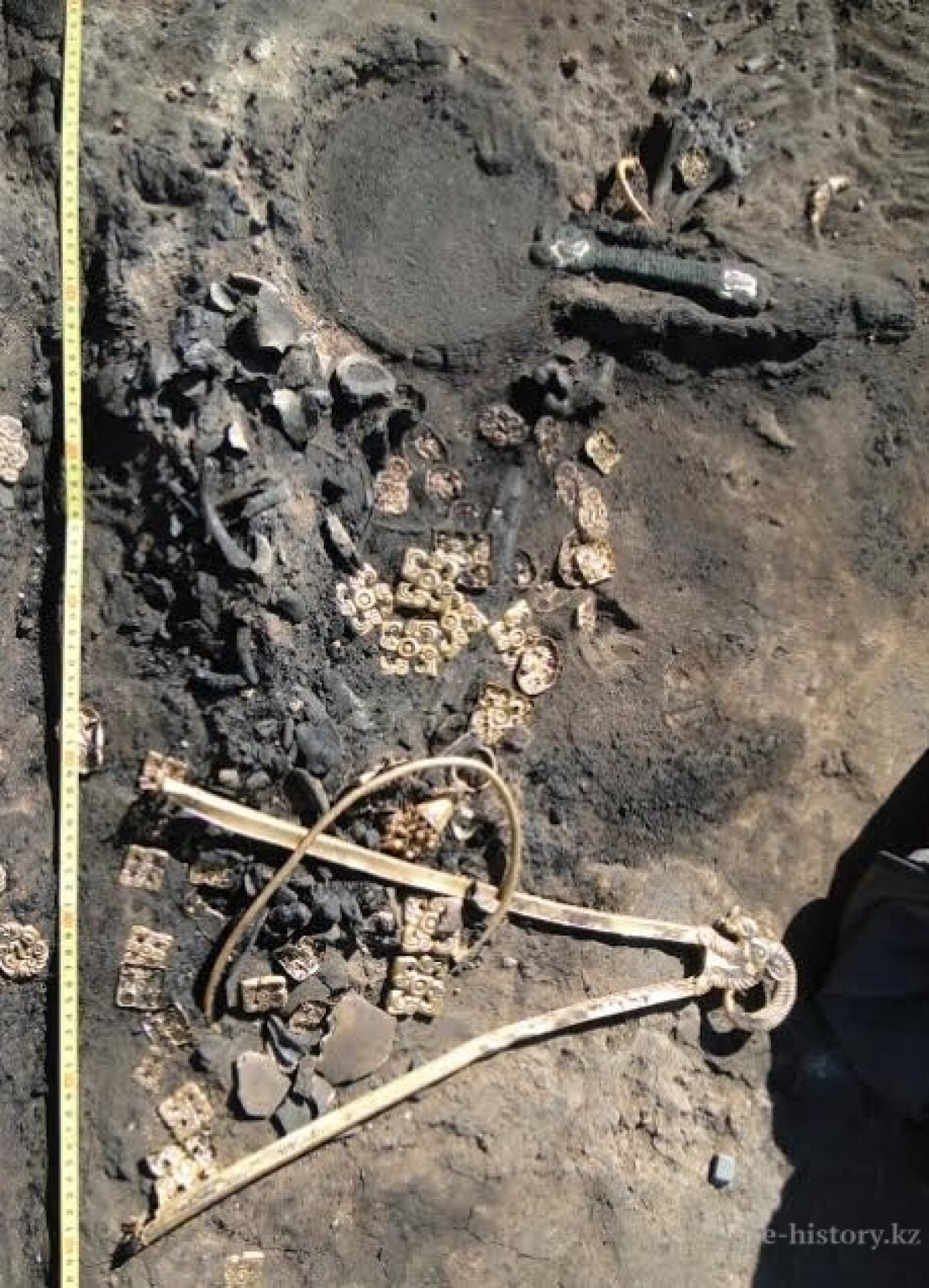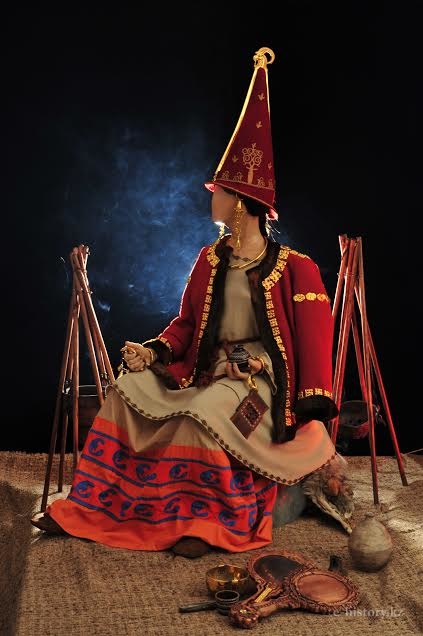
Since 2012, the specialist of West Kazakhstan regional center of history and archeology led by the Doctor of Historical Sciences M. Sdykov and researcher of the center Ya. Lukpanova conduct research of mound complex of Taksay 1 in Terektinsky district of West Kazakhstan.
The complex consists of six embankments. A unique composition that fully preserved burial of female-priest was found in kurgan № 6. An important sign for archaeological searches of the monument became a silver rhyton and a ring, which was found in the area during the arable work 60 years ago.
Before the start of excavation earth embankment of the mound was in one meter height, because it was open. In original form it was significantly higher.
Preliminary dating conducted by the radiocarbon method for residues of wood and bone allowed to talk about the origin of the monument during the late 6th- beginnings of 5th century BC.
Studies of Sarmatian culture in science of the West Kazakhstan center of history and archeology are based on the results of the Ural School of Archaeology, which was formed in Uralsk in the 70 years of the 20th century. It is logical that sarmatologiya is now one of the main, along with the study of medieval urban culture, trends in the work of center. Within 10 years, almost since the founding of the center of history and archeology, has been studied for more than 50 Sarmatian burial mounds, including complexes Segizsay, Kyryk-Oba Buldurta, Oblavka and so on.

In 2012, during excavations by archaeologists of the complex Taksay West-Kazakhstan Center of History and Archaeology was found buried noblewoman of early Sarmatian time. Materials found here, the method of burial, funeral design elements, a large number of ritual objects and articles of gold.
Also cast charred from the fire crest depicting a battle scene caused a wide resonance in the scientific world is well preserved.
Finding of such level is investigated for the first time in the history of the West Kazakhstan. Previously discovered here «golden woman» of complex Segizsay (Lebedevka) of West Kazakhstan region and the «golden warrior Sarmatian» of Atyrau region are significantly inferior in degree of saturation informative decoration and subjects of Taksay complex.

“Golden woman”
It was not accidental the selection of Taksay complex as an object for the excavation. In 1965, according to the experts, items from the arable land belonged to the Sarmatian period.
Among the findings was and silver rhyton, soon became widely known in scientific circles. Only in 2012, after 37 years, the place of random findings was investigated and four mounds complex were defined. Since that time an annual archeological work was held.
During the field season, three mounds were excavated. In the first two barrows found ordinary burials, which gave interesting, but a few findings. And only the last and third mound brought largely unique material.
We introduce the results of the study of artifacts from Taksay complex. All studies were carried out on the basis of the West Kazakhstan Center of History and Archeology. Scientist and specialists of Astana and Almaty, Tokyo (Japan), Bochum and Frankfurt Düsseldorf (Germany), Moscow, St. Petersburg, Orenburg, Chelyabinsk, Pushchino and Novosibirsk were invited to work.
Specialists of scientific restoration workshop, led by well-known artist and restorer of Kazakhstan, together with scientists from the center prepared sculptural reconstruction of the woman who is now exhibited in the National Museum of History in Astana. Here there are all original findings. In Uralsk exposed second sculpture and copies of key artifacts.

“Taksay comb”

“Reconstruction of the comb”
Comparing the parameters and splendor of Taksay complex’s burial mound is less than the famous Scythian monuments as the Issyk, Solokha, Cheromlyk, Oguz and so on. However, the number and variety of article of precious metals, wood and bronze found here, the complexity of the construction of the burial it may compete with the rich Scythian and Saka burial, and some items can be called unique and previously unknown in the scientific world. The study of the monument showed promising meticulously research, give additional information are available on the study of the material culture of the early nomads of the Southern Urals.
Minor written records of the early nomads, the small number of other sources — all this makes it difficult to characterize the life of the early Iron Age tribes in full. Therefore, the basis for the study of ancient history and culture of the nomads are materials excavation of archaeological sites. Mounds mostly looted in antiquity and archeologists had to reconstruct the burial monument design, and collect fragments of artifacts literally bit by bit.
Fortunately, the mound № 6 of Taksay 1 complex is one of those rare monuments, which passed the fate of predatory intervention.
The questions of the origin and evolution of the culture of the early nomads of the Southern Urals remain relevant.
There are different points of view about the time and stages of the culture of the early nomads of the region. They were expressed in the writings of M. Rostovtsev, B. Grakov, K. Smirnov, L. Yablonsky, B. Zhelezchikov, S. Gutsalova, R. Ismagilov and other scientists. Summarizing their assumptions, we are inclined to the idea of combining the two flows of migrants and the indigenous population at the end of 4th-5th centuries BC on the territory of the Urals.
By the middle of the 5th BC the process of building a culture of early nomads is influenced by Eastern Europe and the Scythians Sakas Aral Sea region. Nomadic and semi-nomadic tribes of the Aral Sea region appeared in Western Kazakhstan and South Urals by the end of the 5th century BC. It is very likely that their appearance here due to the strong military pressure on the Iranian Achaemenid Massagets and resettlement of them in the southern Ural steppes (Tairov Botalov, 1996). As a result of the complex ethno-political processes in the region develops Uralic culture of nomads, which is a symbiosis of several large ethnic groups, which was the beginning of the formation of the Prokhorov culture. The current culture of the early nomads of western Kazakhstan, as well as the Southern Urals — a «fusion of the initially heterogeneous ethno-cultural formations, had a different spatial and genetic origin» (Yablonsky, 2008).
The results of long archaeological research in the Urals showed that the population of the region in the early Iron Age to create an independent and unique culture. Talking about the culture of the tribes of the region, L. Yablonsky notes that, occupying the territory of the border with the Scythians and Sauromats in the west, in the south of the Sakas, the settled population of the forest-steppe in the north and in the east (in the Urals), kindred and friends language Priuralsky nomads played a huge role in the dissemination of the latest achievements of technology and culture that time, the vast expanses of the Eurasian steppe from the Balkans to northern China.
In the early Iron Age the significant progress was achieved in metalworking techniques, the professional level of masters, especially jewelers, was raised here.
Found various ornaments made of gold, silver, bronze indicate that the ancient jewelers mastered the various methods of manufacturing products. These are the methods of forging, engraving, embossing, low relief, inlay and gold plating. Jewelers made by them were excellent in execution. At the same time reflect the specifics and peculiarities of perception of the world of nomads. Along with local products, a substantial part of the material culture of the early nomads of western Kazakhstan and Southern Urals were imported items that reflect the direction of economic, political and cultural ties between nomads.
Early nomads did not leave the settlements, but in the Kazakh steppe numerous monuments of that era remained. Kurgans — the silent witnesses of the existence of Nomads. They contain a wealth of information and a source of knowledge about the history of the region during the early Iron Age.
M.Sdykov,Doctor of Historical Sciences
Ya. Lukpanova. researcher at the West-Kazakhstan Center of History and Archaeology

